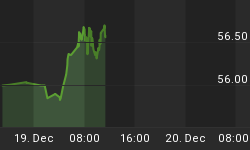Ok, this is becoming an issue with this market. When looking at the sentiment data, we note 3 things. One, the bearish extremes in investor sentiment are not too extreme. The recent bearish extreme in the "dumb money" indicator (i.e., bull signal) has lasted all but one week. The last signal on June 8, 2012 lasted all but one week as well. Our models (over 20 years of data) usually see 2 or more weeks of bearishness amongst investors before a bottom is forged. Two, there is no consensus among the various sentiment data. For example, company insiders (i.e., the "smart money") are typically buying when the "dumb money" is selling. But this past week, we find company insiders actually selling to a degree last seen when the Fed announced QE3. Three, there are no bears. When looking at the leveraged Rydex investors (personal data), we find that they are becoming more bearish, but they haven't acted on that bearishness. They essentially have moved to the safety of the sidelines. Without committed and invested bears, there will be no short covering, and without short covering, there will be little fuel to power any rally. So the problem with this market is that it can't seem to sell off enough to produce a sustainable rally. There are not enough bears or bulls. If the market went lower, we would see more of each.
As expected, the market has found a floor. Holiday trading, hope and the expectation for a fiscal cliff resolution, and fading the "dumb money" are some of the reasons. But the rubber band isn't stretched too far. However far the rally goes, it will likely be a part of what will eventually be recognized as a market top.
The "Dumb Money" indicator (see figure 1) looks for extremes in the data from 4 different groups of investors who historically have been wrong on the market: 1) Investors Intelligence; 2) MarketVane; 3) American Association of Individual Investors; and 4) the put call ratio. This indicator is neutral. If the indicator had stayed bearish for two consecutive weeks, it would have been a bullish signal.
Figure 1. "Dumb Money"/ weekly
Figure 2 is a weekly chart of the SP500 with the InsiderScore "entire market" value in the lower panel. From the InsiderScore weekly report: "Market-wide sentiment has improved, moving from a Slight Sell Bias to Neutral. The change coincides with the triggering of Industry Buy Inflections - our strongest quantitative indicator - within the Russell 2000 and Energy and Financial sectors."
Figure 2. InsiderScore "Entire Market" value/ weekly
Figure 3 is a weekly chart of the SP500. The indicator in the lower panel measures all the assets in the Rydex bullish oriented equity funds divided by the sum of assets in the bullish oriented equity funds plus the assets in the bearish oriented equity funds. When the indicator is green, the value is low and there is fear in the market; this is where market bottoms are forged. When the indicator is red, there is complacency in the market. There are too many bulls and this is when market advances stall. Currently, the value of the indicator is 61.76%. Values less than 50% are associated with market bottoms. Values greater than 58% are associated with market tops. It should be noted that the market topped out in 2011 with this indicator between 70% and 72%.
Figure 3. Rydex Total Bull v. Total Bear/ weekly
TheTechnicalTake offers a FREE e-newsletter: HERE
Visit TheTechnicalTake website: HERE
















